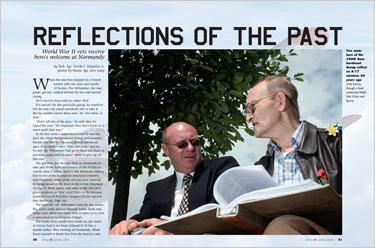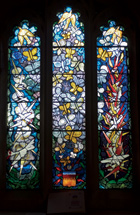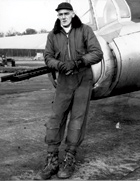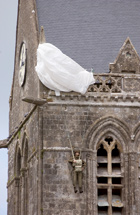


World
War II vets receive hero’s welcome at Normandy
When the tour bus stopped in a French hamlet with one store and maybe
10 homes, Par Nilhammer, the tour guide, got out, walked behind the bus
and started crying.
He’d recently been told his father died.
If it weren’t for this particular group, he would’ve left
the tour and asked somebody else to take it. But he couldn’t desert
these men. No. Not these 12 men.
“Don’t tell any of the guys,” he said after he wiped
his eyes. “It’s important they don’t know so it won’t
spoil their tour.”
In the bus were a dozen World War II veterans from the 398th Bombardment
Group and assorted friends and families. Because of their advanced ages,
they called it their “One Last Look” tour to France. Mr. Nilhammer
had given them two tours in previous years, and he wasn’t about
to give up on this one.
The previous day he took them to Normandy to take part in the 60th anniversary
of the D-Day invasion, June 6, 1944. Amid 9,386 American military laid
to rest at the Normandy American Cemetery and Memorial, many of the retirees
were honored by being seated at the front of the crowd. President George
W. Bush spoke, and some of the vets were given earpieces so they could
listen to the interpretation of French President Jacques Chirac’s
speech (see Notebook, Page 48).
The next day, Mr. Nilhammer took the bus across flat, curvy roads that
cut through barley fields and hedge rows about five miles west of Saint
Lo to visit a monument at La Chapelle Enjuger.
The battle there would have made an epic mark in history had it not been
eclipsed by D-Day a month earlier. After landing on Normandy, Allied forces
needed to break free from the beaches and march through France and into
Germany. Operation Cobra was the answer. On July 25, Army Air Forces and
ground troops savagely attacked the embedded German enemy at La Chapelle
Enjuger. The successful mission was the first of many inland battles that
led to the defeat and destruction of German forces.
This was the first time the Swedish tour guide had ever taken a tour group
there. He hadn’t scheduled anything — just a quick peek at
the monument, then he’d load them on the bus again. But something
spontaneous happened on this trip.
As the 80-year-old vets shuffled across the road to look at the Operation
Cobra monument, they noticed a woman placing fresh flowers next to it.
When she saw them, she jumped up and started to excitedly speak in French.
When Theresa Maquerel realized she wasn’t being understood, she
reached into one of her pockets and pulled out a newspaper article, faded
and wrinkled from use. She pointed at a family portrait: Mother, father,
sons and daughters. In the picture, the family was all smiles. It was
obviously taken well before the Germans occupied the town for four years.
Underneath the picture, in English, a caption explained how Operation
Cobra leveled the little hamlet in July 1944. It also told of a 2-year-old
girl who ran into the woods and survived America’s saturation bombing.
The 62-year-old woman before them was that 2-year-old girl. As though
reliving that moment 60 years ago, Mrs. Maquerel thanked all the veterans
profusely for what they had done.
“Had it not been for the Americans’ kindness of giving me
milk and food I would have starved to death,” she said to Mr. Nilhammer,
who interpreted for the group.
To show her appreciation, every day she places fresh flowers at the foot
of the monument.
Retired Maj. Keith Anderson, a former B-17 Flying Fortress pilot, remembered
the operation, at least from his view at 30,000 feet. On July 24, 1944,
he and his 10-man crew, along with 1,600 Allied aircraft, carpet-bombed
an area three-and-a-half miles by one-and-a-half miles square. La Chapelle
Enjuger was in their Norton bomb sights.
By the end of Operation Cobra, 2,500 aircraft had dropped 6,000 tons of
bombs in a week. At that time, it was the biggest ground support mission
of the war.
From his view, the major didn’t get the full effect of the bombing
campaign. But those on the ground, like Pulitzer prize-winning journalist
Ernie Pyle, did.
“Then a new sound gradually droned into our ears, a sound deep and
all-encompassing with no notes in it — just a gigantic faraway surge
of doom-like sound. It was heavies. They came from directly behind us.
At first they were the merest dots in the sky. I had a feeling that even
had God appeared beseechingly before them in the sky, with palms outstretched
to persuade them back, they would not have had it within them the power
to turn from their irresistible course. Then the bombs came. They began
like the crackle of popcorn and almost instantly swelled into a monstrous
furry of noise that seemed surely to destroy all the world ahead of us,”
Mr. Pyle wrote.
He added, “The Air Force was wonderful throughout the invasion and
the men on the ground appreciated it.”
The attack is said to have killed 70 percent of the Germans in that area.
To this day, villagers break their chainsaws when they ricochet off of
shrapnel imbedded deep inside tree trunks.
Nelly Villegieu, the village mayor, also stopped by the monument while
the vets were there. She told them how she became a refugee and how Americans
looked after her.
“I survived because of Americans. Even though we lost our homes,
that was no problem because we were set free. France is free, and we’re
free, thanks to you,” the mayor said as she shook the hands of everyone
in the group.
The members of the bombardment group didn’t know what to think when
they climbed back onto the tour bus. It was just one of the many such
special moments during their two-week tour. Later that same afternoon,
in Bayeux, they were presented with Normandie Memoire 60th anniversary
commemorative medals. Reporters were all over, snapping pictures and interviewing
the veterans as if they were celebrities.
It seemed that wherever they went, French people wanted their autographs.
When they stepped off the ferry that took them from England to France,
they walked between two rows of British sailors and marines, all of whom
were applauding and shaking hands with the veterans. At the end of the
line: French Adm. Jean-Louis Battet and England’s first Sea Lord
and Chief of Naval Staff Adm. Sir Alan West, who greeted each with a handshake.
The unexpected welcome was so touching a couple of people on the tour
cried.
“The people in France are really nice, nothing like I expected,
and they changed my perception of them,” said Karen Clement, daughter
of deceased 1st Lt. Ray Stange, a group navigator and bombardier. She
was one of the many family members on the tour. Lieutenant Stange’s
widow, daughter and grandson were there.
“I was surprised at how appreciative the people of France were of
the men who helped liberate them,” Mrs. Clement said.
Toward the end of their tour, when they visited their old base at Nuthampstead,
England, six veterans posed for pictures at the group memorial. The shiny,
etched stone reflected their images as if they were ghosts.
Sixty years ago they were young, energetic 20-year-olds. The world was
at war, and they were liberators. Much has changed since then. In June,
they were 80-year-olds and on a One Last Look tour. But one thing remained
the same. The people of France still treated them like heroes.


A stained glass window in an English church depicts the crash of a B-17
Flying Fortress. The 398th Bombardment Group’s aircraft crashed near
the church during World War II. Portions of the glass display the names
of members of the group.


Staff Sgt. Allen Ostrom poses with the tail gun of his B-17 Flying Fortress
during the winter of 1944 in Nuthampstead, England, after returning from
a bombing mission targeting a chemical products plant near Leipzig, Germany.
The target proved to be one of the toughest and costliest in terms of
lives lost for members of the 398th, which assembled for a “One
Last Look” tour to England and France. Mr. Ostrom, who now lives
in Seattle, also served as the unofficial photographer with his 1920’s
vintage Kodak Brownie Hawkeye. On this day, someone offered to photograph
the photographer.

A mannequin hangs on a church overlooking the celebration of the 60th
anniversary of D-Day. Sixty years ago, paratrooper John Steel got caught
on the church and hung for hours before being cut down and taken prisoner
by the Germans. He was later released and an effigy hangs on the church
throughout the year in his honor.

Sally B, a B-17 Flying Fortress, flies over the 398th Bombardment Group’s
memorial at Nuthampstead, England. It’s the same type of aircraft
the crews flew during World War II.
